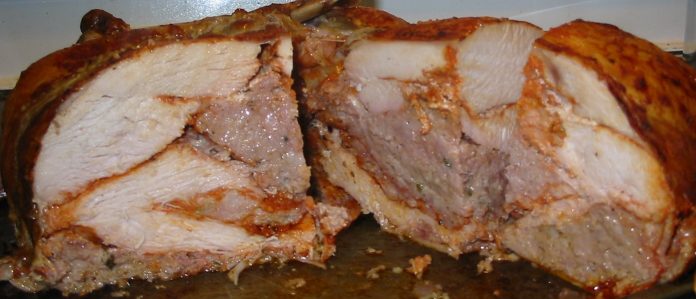
Thanksgiving is my favorite holiday. There’s nothing better than sitting down with family to eat a big meal and enjoy each other’s company.
Our Thanksgiving feast probably looks a lot like most Americans’ dinners — turkey, stuffing, mashed potatoes, gravy, rolls, corn, yams and green bean casserole. However, we do deviate from tradition a little bit when it comes to desserts. We like pumpkin pie, but also blackberry pie, rice crispy treats, jello and banana cream pie.
Our Thanksgiving activities are probably pretty in line with what most families do — talk, eat, clean, bicker and watch football. But after dinner, we have our own tradition of playing board games together. Incidentally, that’s my daughter’s favorite part of the day.
Everyone celebrates Thanksgiving in their own way, sticking to traditions and starting new traditions with family or friends. In households all across America, it looks the same and different.
The history of the turducken
It is believed, sometime in the 1970s or 1980s, Louisiana chef Paul Prudhomme deviated from a traditional Thanksgiving menu and stuffed a deboned chicken inside a deboned duck stuffed inside a mostly deboned turkey. And the turducken was born.
The turducken was made popular in 1997 when John Madden tried the dish before the Hall of Famer was set to broadcast a Rams-Saints game from the Superdome. Two weeks later, Madden chose the turducken to be the official “All-Madden Team” food.
Today, families across the United States order commercially-prepared turduckens for Thanksgiving or try to make their own at home.
Preparing and cooking a turducken
Consumers should keep in mind that the complicated assembly of a turducken leaves a lot of room for error. Anyone planning to prepare one for Thanksgiving should follow USDA’s safe steps in food handling, cooking and storage to prevent foodborne illnesses.
Purchasing and storing
- Purchase poultry no more than two days prior to cooking. The raw turkey, duck and chicken should not be stored more than 2 days before deboning, assembling and cooking.
- Store the raw birds in a refrigerator at or below 40 F until you’re ready to use them.
- Make sure each bird is wrapped securely and placed on a plate or casserole dish in the refrigerator to prevent raw juices from contaminating other food.
- If you purchase a commercially-prepared turducken through a mail-order service, make sure it is frozen upon arrival with a cold source and insulated carton. It should be stored in the freezer until it is cooked. If it arrives warm, notify the service and don’t eat it.
Preparing and cooking a turducken
- Always wash your hands in warm soapy water for 20 seconds before and after handling raw poultry.
- Make the stuffing first, but keep the wet and dry ingredients separate until you’re ready to assemble your turducken.
- Begin deboning the birds one at a time, starting with the chicken, then the duck and finishing with the turkey. That way, you can start layering when the turkey is deboned. When you debone the turkey, you can either choose to leave the legs and wings intact or remove them. Throughout the deboning process, make sure to keep the raw poultry and their juices away from other foods. Additionally, there is no need to wash the birds before deboning. It will only increase chances of contamination. While you are deboning each bird, the other two should be refrigerated, so they stay chilled until you’re ready to assemble them. The birds should not be left out of the refrigerator for more than 2 hours throughout the assembly process.
- After all three birds are deboned and ready to assemble, mix your wet and dry stuffing ingredients together.
- Then, begin assembling your turducken. Lay the turkey down first and coat it with a layer of stuffing. Next, place the duck on top of the stuffing layer and coat it with stuffing. Repeat these steps for the chicken layer. Pack the stuffing loosely so that the bird can cook all the way through.
- Fold up the layers and sew the bird back together.
- Cook the turducken immediately, so that bacteria doesn’t spread throughout the stuffing layers. The assembled turducken should be cooked at 325 F until the innermost layers are cooked to a safe temperature of 165 F. You should confirm the internal temperature with a food thermometer, testing it in multiple places in the bird and stuffing layers and at the center of the thickest part.
- Commercially-prepared turduckens should be cooked upon removing them from the freezer by following the package instructions. If there are no instructions, they should be cooked from a frozen state in an oven set to 325 F until they reach a safe internal temperature of 165 F, confirmed by a food thermometer.
- All surfaces and tools that raw poultry touched during the process of assembling the turducken should be washed with hot, soapy water and then sanitized with a solution of 1 Tbsp bleach per gallon of water.
- Turducken should be sliced and served within two hours after cooking. If it is not going to be sliced and served within two hours, it should be sliced into smaller sections and placed in the refrigerator to quickly cool. Placing a whole cooked turducken in the refrigerator will not allow all layers to cool in a safe amount of time to prevent bacterial growth.
- Leftovers should be used within three to four days after cooking.












